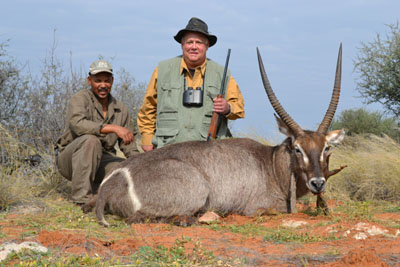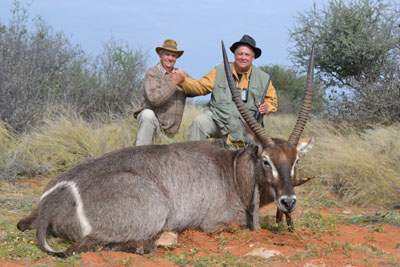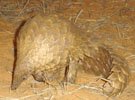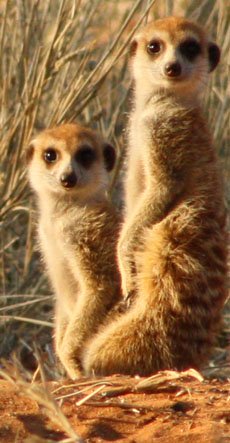For more information about our hunting safaris, don’t hesitate to reach out and contact us!
My Elusive Waterbok
by Stephen J Hofmann
(Illinois)
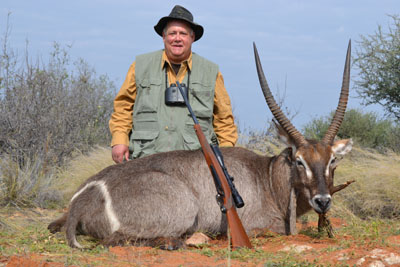
In 2011 my friend Jan guarenteed me a Waterbok for a good price because I was a returning customer and friend.
While dining on Gemsbok steak and Kalahari truffles one evening in May 2011, Jan and I discussed the Waterbok hunt. He said that the Waterbok on his ranch had been hunted heavily and I would go to a nearby farm in the Dordabis Conservancy to hunt the Waterbok. The Dordabis Conservancy is a group of farms that share the hunters with one another. The Dordabis Conservancy offers 400,000 acres to hunt on.
Johannes, Jan's main Professional Hunter, and I went to the other farm and met Gert. Gert had a lot of rain and water on his farm in 2011 and some of the area was inaccesible.
We found a really good Springbok and I shot it with one shot; the first animal I had shot in 2011. I felt good after that. It was a confidence builder. We also saw a good Blue Wildebeest and I shot that also. It took three shots to down the Wildebeest.
But we were after Waterbok. We saw a good female Gemsbok and I took her at 325 yards. By the look of the horns we thought it was a bull, but it was a female and it scored Gold. We were still after Waterbok.
We saw a Waterbok Bull. Johannes and I took off after the bull. Gert saw our every movement during the stalk. We got close to the bull and then it spotted us. It ran off. Gert saw the whole thing. He said we got close for a shot and then the bull took off.
We went back to Jan's farm. Over a meal of Blue Wildebeest cutlets Jan and I discussed the day's events. He said "No Waterbok, no good." Also he was not happy that I had shot a Blue Wildebeest when he had specifically told Gert that we were after Waterbok.
The next day Jan would lead the Waterbok expedition to another farm in the Dordabis Conservancy. Jan had a deal with the owner there to harvest a Waterbok for me.
We drove to the other farm and met Big Aron, the manager. Aron, Jan, Franz, and I got in the bakkie and went into the thornbush covered veldt. We saw many female Waterbok but no bulls. We went to a different part of the farm and saw some small bulls. All of a sudden we saw a magnificent Bull Waterbok. I took a shot and I thought I hit it squarely. The Bull ran off. A blood trail was followed and the Bull had run about 50 yards.
It was down. With one shot through the heart. I was overjoyed!! My first Waterbok!! It was Gold!!
Stephen J Hofmann
Comments for My Elusive Waterbok
|
||
|
||
Meaning of "Uitspan"
'Uitspan' is an Afrikaans word that means place of rest.
When the Boer settlers moved inland in Southern Africa in the 1800's, they used ox carts. When they found a spot with game, water and green grass, they arranged their ox carts into a circular laager for protection against wild animals and stopped for a rest.
They referred to such an action of relaxation for man and beast, as Uitspan.
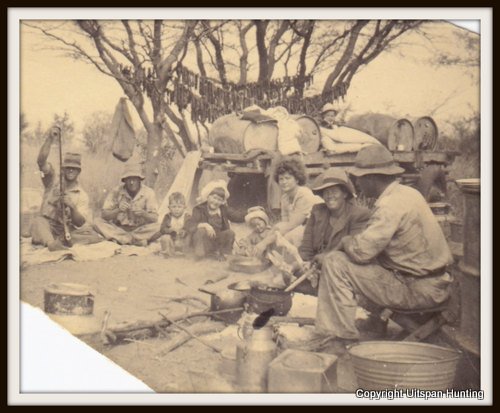
(Picture above of our ancestors.)
Did you know?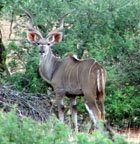 Greater Southern Kudus are famous for their ability to jump high fences. A 2 m (6.56 ft) fence is easily jumped while a 3 m (9.84 ft) high fence is jumped spontaneously. These strong jumpers are known to jump up to 3.5 m (11.48 ft) under stress. |
Did you know? Some animals have one sense more than man!The flehmen response is a particular type of curling of the upper lip in ungulates, felids and many other mammals. This action facilitates the transfer of pheromones and other scents into the vomeronasal organ, also called the Jacobson's Organ. Some animals have one sense more than man!The flehmen response is a particular type of curling of the upper lip in ungulates, felids and many other mammals. This action facilitates the transfer of pheromones and other scents into the vomeronasal organ, also called the Jacobson's Organ.This behavior allows animals to detect scents (for example from urine) of other members of their species or clues to the presence of prey. Flehming allows the animals to determine several factors, including the presence or absence of estrus, the physiological state of the animal, and how long ago the animal passed by. This particular response is recognizable in males when smelling the urine of a females in heat. |
